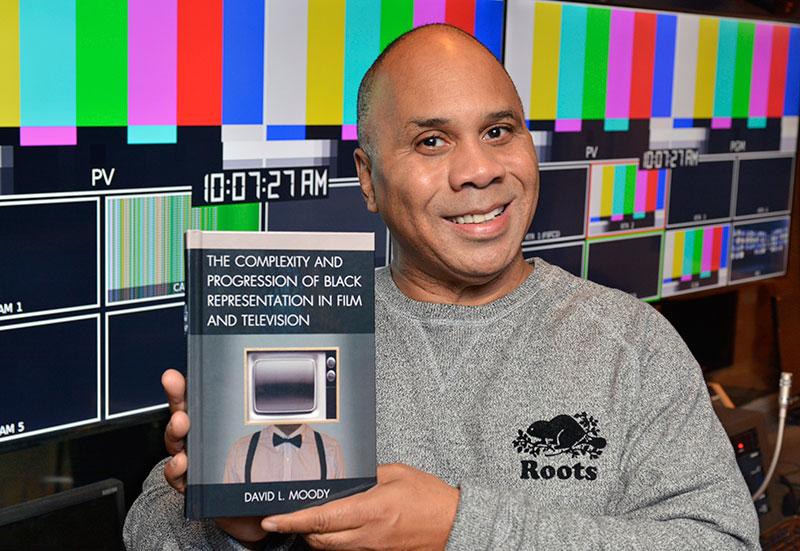Race and film—David L. Moody of the communication studies faculty examines the history of screen portrayals and people’s perceptions in a new book, “The Complexity and Progression of Black Representation in Film and Television.”
Communication studies faculty member David L. Moody leans on his life experience, scholarship and deep interest in the links between screen portrayals and people’s perceptions in a new book that traces depictions of African Americans in “race films” of a bygone era all the way to today’s box office and ratings successes.
“The Complexity and Progression of Black Representation in Film and Television,” published recently by Lexington Books, examines the intricacies of race and representation in historical timeline fashion, but with emphasis on topics such as female black identities, black masculinity, buffoonery and others.
Reviewer Denis Mueller, a filmmaker and creator of “Howard Zinn: You Can’t Be Neutral on a Moving Train” and other documentaries, wrote, “This book is key to anyone who wants to understand the genealogy of American racism and its relationship with the moving image.”
Moody said the book was born of his decades-long observations, his own experiences in broadcasting and as a freelance actor, and his intellectual curiosity about stereotypes and perceptions.
“Since I got started as an undergraduate student at the University of Cincinnati in broadcasting, one of the things I was observing was how African Americans were represented in films and television,” Moody said. “In my studies there and during my graduate work at Ohio University, I started to focus a little bit more intently, if you will, specifically on the perception of some of these constructs of images we as Americans watch on television and in film, some of the takeaways.”
Moody gained further impetus from a 2009 visit with an attorney friend to New York City’s famed Carnegie Deli, now due to shut down at year’s end. “We noticed in areas of the deli itself, you don’t see any black representation,” he said. “There has been plenty of black talent, artists, performers that have gone through. … People often take for granted what they see, then they formulate opinions about other people based off those visuals and images.”
‘Great artists’
Negative portrayals of black people dominated the early 20th century history of white-produced American film and continue right through the buffoonery of more modern television portrayals, Moody said. But nearly all that time there have been black filmmakers working against the tide.
“There were great artists, such as Oscar Micheaux,” he said. “His narrative was in terms of a more positive look at the African American way of life, family and things of that nature. It was complex. He was peddling films on the road and had difficulty getting screenings. In my opinion, before there was Spike Lee, there was Oscar Micheaux—he paved the way for these filmmakers.”
In an appendix of noteworthy black figures in film and television, Moody pays tribute to the work and success of such actors as Denzel Washington and Halle Berry, James Earl Jones and Esther Rolle, and such producers and screenwriters as Shonda Rhimes and Lee. But he also, with contributor Rob Prince Obey, works to unpack the connection of white-produced movies such as “Scarface” and the iconic image of Tony Montana with the effect it made with the hip hop male audience raised under “the code of the street.”
Negative portrayals and perceptions remain, Moody said. He noted that two SUNY Oswego students, broadcasting and mass communication majors Sean O’Halloran, a senior, and Sean Ramundo, a recent graduate, designed the cover art for the book, depicting an old TV with a blank screen atop what would appear to be the body of an African American male.
Has there been progress in portrayals of African Americans in film and on television? “I think there’s been progression, but to what extent?” he said. “To what extent is the screen still empty?”




